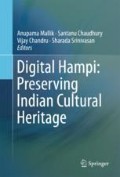Abstract
The Indian Digital Heritage (IDH) Knowledge Bank is a collaborative digital cultural heritage archival project conceptualized and implemented by two interdisciplinary cultural institutions in Bangalore which have been funded by the Department of Science and Technology, Government Of India, for the tasks of collecting, archiving and curating the multimodal content gathered by twenty-seven technology and cultural project teams. A work in progress, this archive is being compiled and developed by an interdisciplinary digital humanities team at International Institute for Art, Culture and Democracy (IIACD) comprising of open-source technologists, communication designers and an art historian. The content being archived includes texts (of varying vintage), audio recordings, still and moving images (2D), 3D point cloud images, mesh and volume models (3D) and multimedia content from the IDH-Hampi projects. There are also technologies and demonstrations of the technologies that are archived as the output of the IDH-Hampi project. In this chapter, we discuss the archival (in this context, we use the term ‘archival’ to indicate the process of collecting and curating cultural content generated by the project) of the multimodal content with the open-source (GNU GPL) archival content management system Omeka (https://omeka.org/) developed and maintained at the Roy Rosenzweig Center for History and New Media, George Mason University. We discuss the test archive and creation of the Knowledge Bank website with Omeka and its tools and plugins, which enable a unified ontology for the IDH project. Computer Scientists have borrowed the concept on ‘Ontology’ from philosophers and use it to encode knowledge of a domain. The ontology is constructed by listing the entities and concepts in the domain and then ascribing meaning to them by adding properties and relations to them. Once these information maps are created, it is possible to build inference engines that can deduce new facts using logical deductions. More advanced artificial intelligence methodologies can use an ontology to recognize concepts and generate recommendations. Also, as demonstrated by the IIT Delhi project on ‘Girija Kalyana’ (a chapter in this volume), the ontology can be used to navigate the content of the knowledge bank using semantically directed (meaningful or ‘intellectual’) paths. The chapter concludes by arriving at a robust ontological scheme to allow for richer and advanced interlinked searches with/between complex semantic text, objects and relationships.
The choice of Omeka as an archival platform for digital heritage was arrived at in consultation with Dr. Sita Reddy, a Fellow at the Smithsonian.
References
Private Communication with Sita Reddy and Annapurna Garimella
http://dh101.humanities.ucla.edu/?page_id=35 UCLA, Center for Digital Humanities
Chaudhury S, Mallik A, Ghosh H (2015) Multimedia ontology: representation and applications. CRC Press
https://www.w3.org/TR/2006/WD-WCAG20-20060427/appendixB.html
Zamon C, (2013) The lone arranger: succeeding in a small repository. Society of American Archivists ChicagoêIllinois Illinois
Hamill L (2013) Archives for the lay person: a guide to managing cultural collections. AltaMira Press
Carmicheal DW (2012) Organizing archival records: a practical method of arrangement and description for small archives. AltaMira Press
Torou E, Katifori A, Vassilakis C, Lepouras G, Halatsis C (2006) Creating an Historical Archive Ontology: Guidelines and Evaluation. In: 2006 IEEE 1st international conference on digital information management, pp 102–109
Gilliland-Swetland AJ (2000) Enduring paradigm, new opportunities: the value of the archival perspective in the digital environment. ERIC
Hunter GS (2003) Developing and maintaining practical archives, 2nd edn. Neal-Schuman Publishers
Jenkinson H (1948) The english archivist: a new profession, being an inaugural lecture for a new course in archive administration delivered at university college. HK Lewis, London, 14 Oct 1947
http://ieeexplore.ieee.org/stamp/stamp.jsp?tp=& arnumber=4221874&isnumber=4221857
http://www.lib.umich.edu/blogs/library-tech-talk/what-omeka-0
http://guides.archaeologydataservice.ac.uk/g2gp/ArchivalStrat_1-0
Acknowledgements
The authors would like to thank a reviewer who provided detailed and constructive criticisms that certainly helped to improve the chapter.
Author information
Authors and Affiliations
Corresponding author
Editor information
Editors and Affiliations
Rights and permissions
Copyright information
© 2017 Springer Nature Singapore Pte Ltd.
About this chapter
Cite this chapter
Chandru, V., Kumar, N.A., Vijayashree, C.S., Chandru, U.V. (2017). Digitally Archiving the Heritage of Hampi. In: Mallik, A., Chaudhury, S., Chandru, V., Srinivasan, S. (eds) Digital Hampi: Preserving Indian Cultural Heritage. Springer, Singapore. https://doi.org/10.1007/978-981-10-5738-0_22
Download citation
DOI: https://doi.org/10.1007/978-981-10-5738-0_22
Published:
Publisher Name: Springer, Singapore
Print ISBN: 978-981-10-5737-3
Online ISBN: 978-981-10-5738-0
eBook Packages: Computer ScienceComputer Science (R0)

